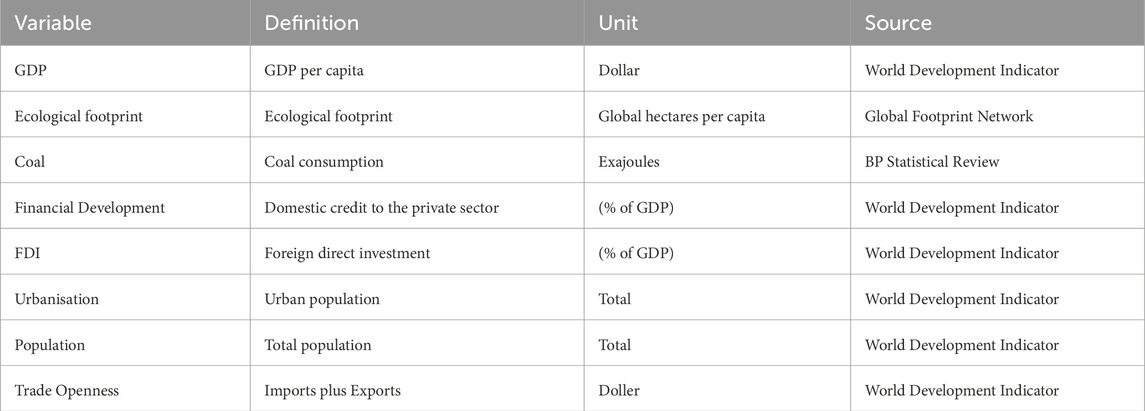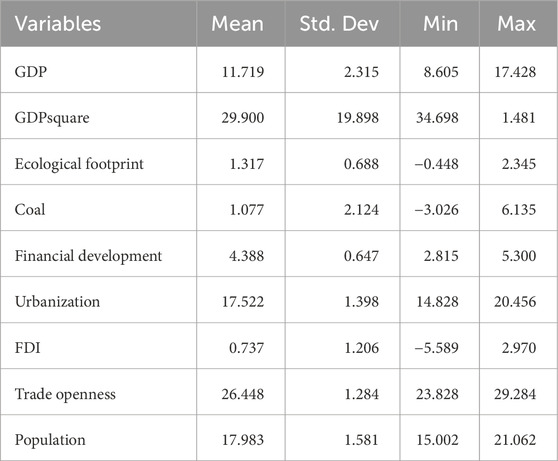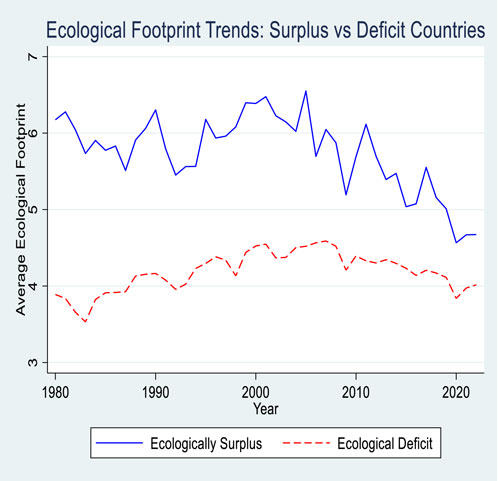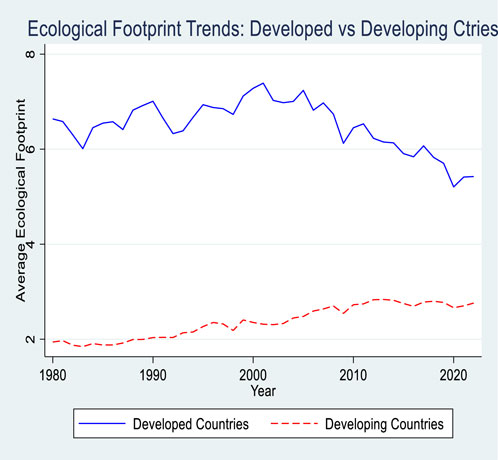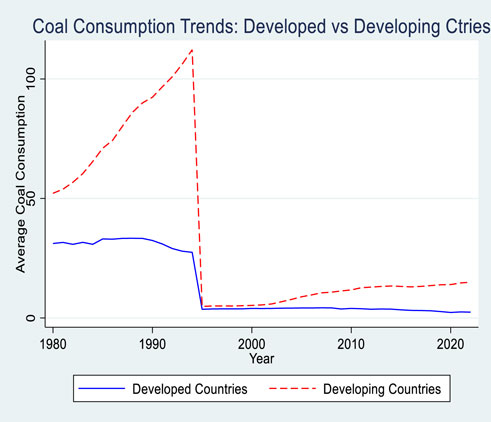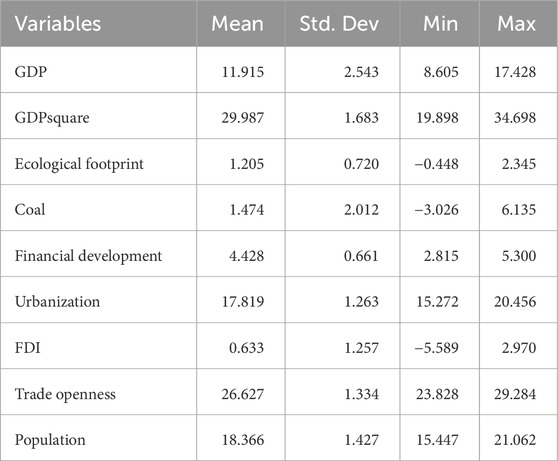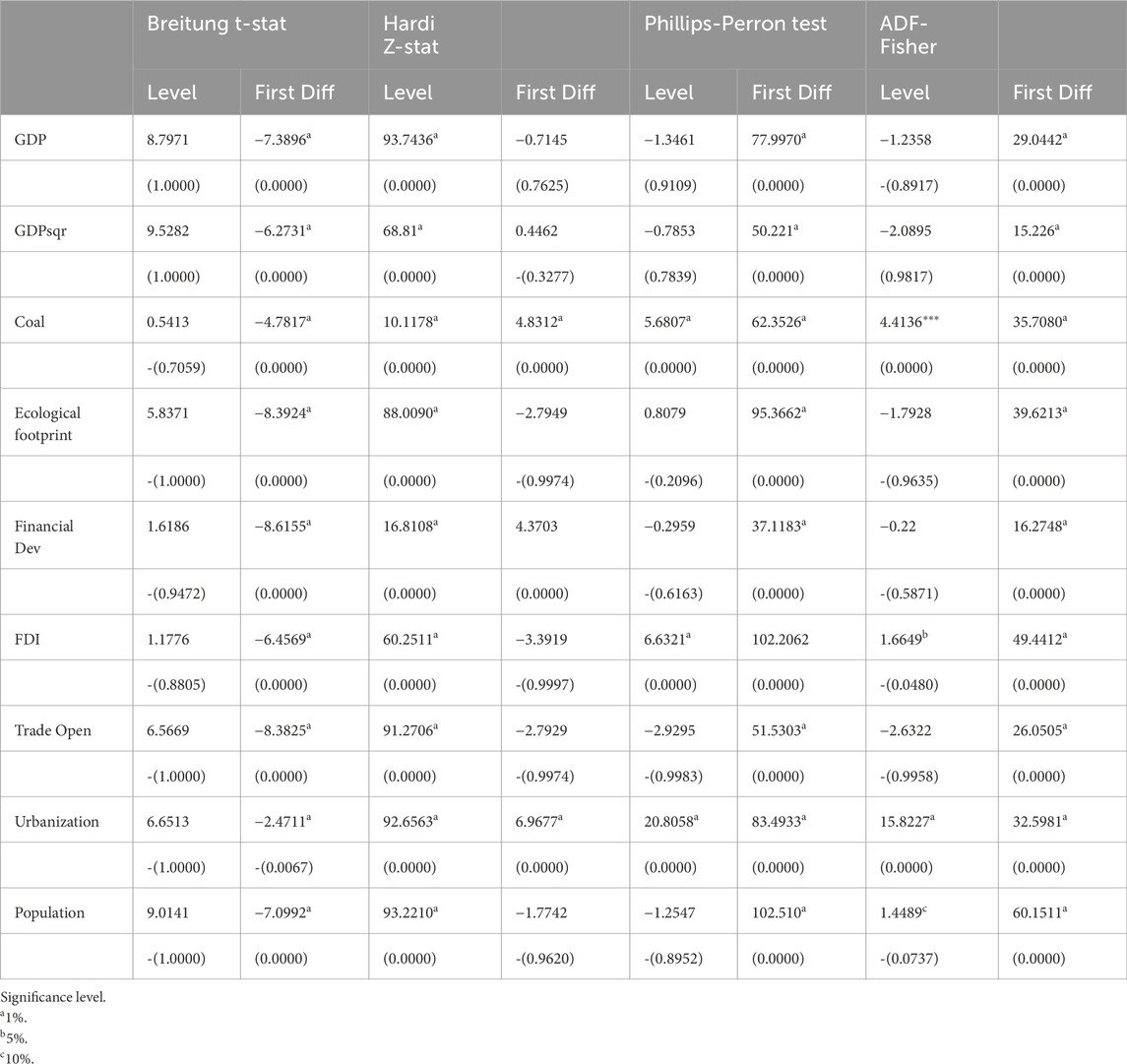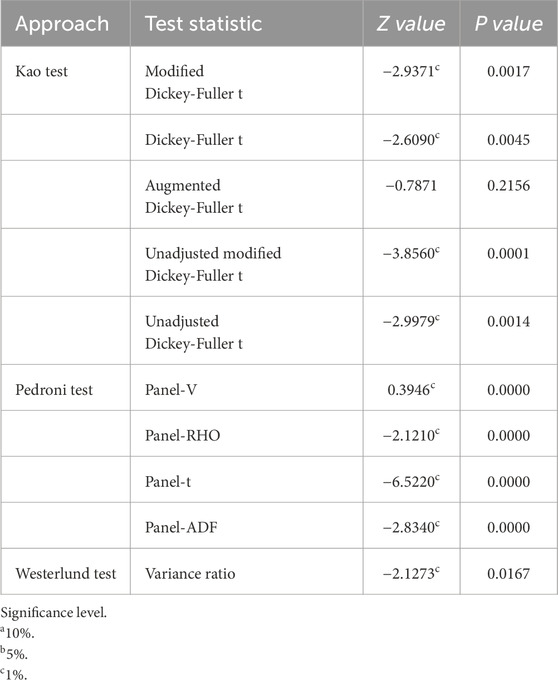- 1Faculty of Hospitality, Tourism and Wellness, Universiti Malaysia Kelantan, Pengkalan Chepa, Malaysia
- 2Environment and Sustainable Development Research Group, Universiti Malaysia Kelantan, Jeli, Kelantan, Malaysia
- 3Sustainable Tourism Group, Faculty of Hospitality, Tourism and Wellness, Universiti Malaysia Kelantan, Pengkalan Chepa, Malaysia
- 4Department of Commerce, School of Business Studies, University of Kashmir, Kashmir, India
Introduction: This study explores the long-run relationship between coal consumption, ecological footprint, and economic growth in 17 coal-dependent countries from 1980 to 2022. This study further examines how ecological footprint and fossil fuel (Coal consumption) influence economic growth across different economic and ecological contexts.
Methods: The study employs Fully Modified Ordinary Least Squares (FMOLS) and Dynamic Ordinary Least Squares (DOLS) estimators to assess long-run relationships. Additionally, the Three-Stage Least Squares (3SLS) method is used to address potential endogeneity and investigate bidirectional and directional relationships among variables. The sample is further categorized into developed vs. developing countries and ecologically surplus vs. ecologically deficient countries to assess heterogeneity in the findings.
Results: Empirical results reveal significant positive relationships between coal consumption, ecological footprint and economic growth in developing and ecologically deficient countries. However, this empirical finding is insignificant in developed and ecologically surplus countries. Additionally, the 3SLS results uncover a bidirectional negative relationship between coal consumption and economic growth, alongside strong directional positive relationships between coal consumption and ecological footprint, and between ecological footprint and economic growth, both significant at the 1% level. Moreover, the Environmental Kuznets Curve (EKC) hypothesis holds true for developed countries.
Discussion: The findings suggest a strong dependence on coal-driven growth in developing and ecologically deficient nations, highlighting sustainability concerns. Policymakers are urged to initiate a gradual shift from fossil fuels, particularly coal, to renewable energy sources. Recommendations include the promotion of public-private partnerships in energy innovation, the implementation of regulatory frameworks for fossil fuel consumption, and the provision of financial incentives for renewable energy adoption. These measures are essential for aligning economic growth with environmental sustainability across diverse economic and ecological landscapes.
1 Introduction
In recent times, environmental sustainability has emerged as one of the most demanding concerns of the 21st century, due to continuous expansion of global economic activities (Ibrahim et al., 2023; Wang et al., 2022). However, rapid economic development and reliance on non-renewable energy sources have led to significant environmental concerns, including climate change, biodiversity loss, and greenhouse gas emissions (Awosusi et al., 2023; Destek and Aslan., 2017). Recognizing the urgency of transition to cleaner energy sources, reduce carbon footprints, and achieve sustainable development goals, nations worldwide have come together under critical international agreements, for example, Kyoto Protocol 1997, followed by the landmark Paris Agreement 2015, aims to keep the global average temperature well below 2°C above pre-industrial levels, with efforts directed at limiting the increase to 1.5°C (Alper et al., 2022; Awosusi et al., 2023; Jie et al., 2023). Additionally, the annual Conferences of the Parties (COP) under the United Nations Framework Convention on Climate Change (UNFCCC) have provided a platform for countries to negotiate and collaborate on climate strategies, the recent conference COP28 held in Dubai, signalled a significant milestone in transition away from fossil fuels, highlighted the need for a swift, equitable, and equitable transition, supported by substantial emissions reductions and enhanced financial mechanisms, ensuring to maintain the global temperature within the 1.5° threshold.
In the era of climate change, coal stands out as the most cost-effective and abundant fossil fuel globally, catalysing global development, electricity generation and poverty alleviation (Kanat et al., 2022). In emerging economies, coal remains a significant energy resource, fuelling rapid industrial expansion and urbanization, primarily due to its substantial reserves, lower prices, affordability, and reliability in providing consistent energy (Chang et al., 2017). These factors have positioned coal as a preferred fossil energy source for many countries seeking to meet their energy demand (Al-mulali & CheSab, 2018). In contrast, developed nations towards shifting towards cleaner energy alternatives, have make it a cornerstone for energy security through coal efficiency (Awosusi et al., 2024), action to cut methane emissions from coal mines and carbon capture storage (CCS) technologies (Li, 2023a; Li, 2023b). However, coal contributes to severe environmental challenges through greenhouse gas emissions, exacerbating climate change. Coal accounts for approximately 15.5 GH of global carbon emissions due to increase in global coal-fired power generation by 2%, leading to record-high CO2 emissions from coal-fired plants (International Energy Agency 2022). Consequently, the combustion of fossil fuels, especially in the form of coal, has resulted in significant environmental degradation and deterioration, posing an urgent climate challenge and negative health effects on humans (Li et al., 2022), ultimately resulting in higher healthcare costs (Chang et al., 2017). Moreover, as economies grow and industries flourish, the demand for coal energy, natural resources, and land increases, thereby decreases the environment quality (Hassan et al., 2019; Kim and Yoo., 2016; Tauseef et al., 2019).
The ecological footprint, as a critical measure for assessing the environmental impact of human activities on the planet (both productive land and sea areas used for consumption and production) (Wackernagel and Rees, 1998), thus provides a holistic approach on the pressure humans exert on the planet. The ecological footprint offers a comprehensive measure of environmental sustainability than traditional measure, i.e., carbon emission, by integrating various dimensions of human impact, such as carbon emissions, resource consumption, and land use (Wang et al., 2022). The rapid increase in domestic and industrial production, resource utilization, and energy consumption in developing countries has accelerated ecological footprints (Wang et al., 2022). As a result, energy consumption, vital for economic growth intensifies resource exploitation, leading to higher fossil fuel use and CO2 emissions, thus reduces the environmental quality (Majeed et al., 2021). This paradox of economic dependence on coal and the need for ecological sustainability has stimulated a critical discourse on the trade-offs between coal consumption, ecological footprints, and economic growth, in order to design and implement robust policies that facilitate the transition from fossil fuels and promote long-term environmental sustainability.
Against this backdrop, this paper primarily aims to evaluate the impact of coal consumption and ecological footprint on economic growth in the top 17 coal consumption countries. Previous studies (e.g., Danish et al., 2018; Kongkuah et al., 2021) have used the conventional proxy for environmental degradation, i.e., carbon dioxide (CO2) emissions. However, CO2 does not encompass the multi-dimensional aspects of environmental quality (Altıntaş and Kassouri, 2020; Dogan et al., 2020). Therefore, this paper uses the ecological footprint (EF) as a proxy for environmental quality, introduced by Wackernagel and Rees (1998) to address the limitations of CO2 emissions. The ecological footprint (EF) measures the environmental adversities concerning bio-productive land area, which is used by humans for their diversified desires and adjusts the wastes generated by humans in the process (Rees, 2000). We employed the Fully Modified OLS, Dynamic OLS, and three-stage least squares (3SLS) to achieve the study’s objectives.
The contributions of the study are fourfold. Our study is among the recent studies that established an asymmetric relationship between environment and growth, which supports the conditional EKC hypothesis. Our findings reveal that the relationships between coal consumption, ecological footprint, and economic growth across coal countries vary significantly depending on their levels of development and ecological stratifications. We find that coal and ecological footprint significantly promote economic growth in developing and ecologically deficit countries, while developed and ecologically surplus countries experience significant negative impacts. This suggests new insights in energy literature that the turning point of the EKC hypothesis differs following a country’s income level and resource capacity. Methodologically, our paper integrates ecological surplus and deficit classifications into the analysis of energy-growth-environment dynamics by offering a more sustainability-aligned framework, beyond the traditional standard GDP-based classifications. Thus, our findings encourage the need for localized policy insights.
Second, our study contributes to the growth hypothesis, particularly in ecologically deficient countries where coal consumption and ecological footprint drive growth. Unlike most prior studies (Apergis and Payne, 2010; Jia et al., 2022; Jim and Kim, 2018), our findings establish that despite global energy transition discourse and policy narratives, coal consumption remains a significant growth determinant for lower-income or developing economies. Similarly, we find strong support for the EKC hypothesis across developmental stages, with GDP and GDP square having both positive and negative effects on coal consumption, respectively. Therefore, our findings add theoretical robustness to the integration of growth and EKC hypotheses. Third, in contrast to studies that assume the energy-growth relationship as unidirectional causality, we treat the coal-growth models as jointly determined systems using three-stage least squares (3SLS), which account for endogeneity, simultaneous causality, and feedback effects. For instance, coal consumption and ecological footprint significantly impact GDP, while GDP and ecological footprint significantly impact coal consumption, which reinforces the presence of two-way causality.
Third, unlike previous studies (Chang et al., 2017; Salahuddin et al., 2018) that have relied on Granger causality tests to understand the causal relationship between variables despite it being an insufficient measure of economic causality (Malik, 2021), we employ the simultaneous equation modelling approach using the three stages least square (3SLS) proposed by Zellner (1992). This approach allows for interdependence between regressors and regressand (Malik, 2021), and provides consistent, reliable and unbiased results by solving the correlation between unobserved error and regression terms (Ren et al., 2021). This paper incorporates relevant explanatory variables in every equation of 3SLS to overcome the problem of omitted variable bias. Unlike past studies that used Granger causality to find a unidirectional relationship between coal and economic growth and support for the neutrality and feedback hypotheses (Chang et al., 2017; Lin et al., 2018), our study in the use of the 3SLS finds a bidirectional negative relationship between coal consumption and economic growth. Also, we find directional positive relationships between coal consumption and ecological footprint and between ecological footprint and economic growth at the 1% level. Our findings of the ecological footprint model using 3SLS confirm the EKC hypothesis in developed countries while it is not confirmed in developing and ecological surplus countries, suggesting that environmental quality starts to improve at the same time as economic growth (Pata, 2018), due to increasing level of environmental awareness, stringent environmental regulations and the transition to low-carbon production technologies (Anoruo, 2017).
Lastly, by conducting sub-sample analysis, this study provides insights into the divergent effects of different ecological typologies (i.e., ecological deficit and ecological surplus) on economic growth by analysing data from the global ecological footprint. Countries with ecological surpluses may enjoy favourable economic growth as a result of sustainable resource management, whereas ecological deficit countries are confronted by the challenges and possible risks of resource depletion and environmental degradation. Our findings show that in ecological deficit countries, both coal consumption and ecological footprint have a positive and significant impact on economic growth. Conversely, in ecological surplus countries, coal consumption exerts a positive but insignificant influence on economic growth, while ecological footprint exhibits a positive and significant impact on economic growth. This subsample analysis provides policymakers and stakeholders with insights for formulating sustainable development strategies, fostering responsible environmental behaviour, as well as achieving an equilibrium approach to growth in the economy that incorporates ecological considerations into account.
The remainder of the paper is organised as follows. The literature review section provides a related literature review. The “Data and Methodology” section offers the data and econometric methodology. The “Empirical Results section present the empirical results. The last section provides “Discussion and Conclusion.
1.1 Theoretical background
The Energy-Growth nexus is a fundamental theory used to explores the dynamic relationship between energy consumption and economic growth,highlighting four key hypotheses: (1) Growth Hypothesis (EC→GDP),where energy consumption drives economic growth; (2) Conservation Hypothesis (GDP →EC),where economic growth reduces energy consumption through efficiency: (3) Feedback Hypothesis (EC↔GDP),suggesting mutual reinforcement between energy consumption and growth; and (4) Neutrality Hypothesis (EC ⊥ GDP),indicating no relationship between energy consumption and economic growth (Chang et al., 2017; Destek, 2016; Jia et al., 2022; Rahman and Velayutham, 2020).
Moreover, the Environmental Kuznets Curve (EKC) hypothesis is a widely recognized framework for examining the relationship between economic development and environmental quality, developed by Grossman et al. (1991) and coined by Panayotou (1993). This hypothesis assumes that environmental degradation tends to increase during the early stages of economic growth due to factors such as a lack of environmental awareness, inadequate funds allocated for environmental protection, and a scarcity of advanced pollution-preventing technologies. However, as economic development reaches to a mature point, the hypothesis suggests that economic growth can lead to a reduction in environmental degradation, through the adoption of cleaner technologies, increased environmental awareness, shifts in industrial sector towards greener sectors and environmental sustainability (Li and Li., 2011; Wang et al., 2022).
1.2 Empirical literature
The literature extensively investigates the relationship between coal consumption, ecological impact, and economic growth. In summary, we divide the available literature into two major strands: first, we investigate the relationship between coal energy use and economic growth; second, we investigate the relationship between economic growth and ecological footprint.
1.2.1 Coal consumption and economic growth
There is widespread agreement that increasing the consumption of fossil energy sources increases economic growth. As per the British Petroleum report in 2012, coal reserves are dominant contributors to the global energy mix. As a result, coal has become one of the world’s primary and critical energy sources (Kanat et al., 2022). Numerous noteworthy research has been carried out over time to thoroughly study the distinct relationship between coal consumption and economic growth. For example, Nasiru (2019) confirms the long-run relationship between coal consumption and economic growth in Nigeria. Further, the conservation hypothesis was confirmed between coal consumption and economic growth. In another study, Jin and Kim (2018) support the growth hypothesis between coal consumption and economic growth in 32 non-OECD countries, from 1990–2013. Further, Al-mulali and Che Sab (2018) confirm the neutrality hypothesis in the top ten coal-consuming countries from 1992 to 2009. Similarly, in BRICS, Chang et al. (2017) evidenced the growth hypothesis for China, the feedback hypothesis for India, the conservation hypothesis for South Africa and the neutrality hypothesis for Brazil and Russia.
1.2.2 Cological footprint and economic growth
This section highlights the relationship between environmental degradation-economic growth. The relationship between environment and economic growth was largely based on EKC in various countries and regions using carbon emission as an indicator of environmental pollution, for example, Al-mulali et al. (2015) confirm the EKC hypothesis in 93 countries, Shahbaz et al. (2019) confirmed in G-7 countries, Wang et al. (2022) confirmed in China, Danish et al. (2018) and Rahman and Ahmad (2019) validated in Pakistan. However, some studies do not support the EKC hypothesis in 31 Asian countries (Aye and Edoja, 2017), the EU (Dogan et al., 2020), and China (Kongkuah et al., 2021).
In recent years ecological footprint has emerged as a new indicator of environmental degradation, surpassing the sole focus on carbon dioxide emissions. It provides a more comprehensive and quantitative measurement of sustainable development by evaluating the extent to which human activities have an impact on the environment (Ashir et al., 2017). Several studies have used ecological footprint as an indicator of environmental degradation, for example, Tauseef et al. (2019) found that economic growth increases the ecological footprint in Pakistan in both the long and short run. Some studies also confirmed the EKC for economic growth and ecological footprint. Similarly, Ulucak and Bilgili (2018) confirmed an inverted U relationship between economic growth and ecological footprint in middle and high-income countries. The authors confirm increases in economic growth increase the ecological footprint up to a certain limit and decrease later. Also, Charfeddine and Mrabet (2017) confirm the EKC in 15 MENA countries. Nathaniel and Nathaniel (2020) confirmed EKC between economic growth and ecological footprint in N-11 countries. In addition, the ecologically induced EKC was also confirmed between economic growth and ecological footprint in West Asian and Middle east countries (Kihombo et al., 2022). Also, Chaudhry et al., (2022) confirmed the presence of the EKC hypothesis between financial inclusion and ecological footprint. Hence, results from an EKC analysis are highly sensitive to the selection of independent variables included in the analysis. Therefore, it is crucial to consider suitable macroeconomic variables that may affect the connection between economic growth and ecological footprint (Dogan and Inglesi-Lotz, 2020).
Prior studies (see Adebayo et al., 2021b; Adebayo et al., 2023; Ding et al., 2023) have investigated the relationship between coal consumption on environment degradation across regions, and nations. However, to the best of our knowledge, there has not been any research that have investigated the combined impact of coal consumption and ecological footprint on economic growth in top coal consuming countries, where coal constitutes a significant portion of fossil fuel consumption and environmental degradation. Additionally, most research generalizes findings across regions or on major economies, neglecting inconsistencies in energy consumption patterns and environmental degradation status. By limiting the focus to the top seventeen coal-consuming countries, this study provides an understanding of the relationship between coal consumption, ecological degradation, and economic growth in these coal-centric contexts. Moreover, previous studies predominantly rely on carbon emissions to measure environmental quality, overlooking a more comprehensive measure of environmental quality, i.e., ecological footprint, which provides a more holistic assessment of environmental quality by accounting for various dimensions of human impact on natural ecosystems. Furthermore, studies have employed traditional econometric approaches like the Granger causality method. In contrast, this study employs a three-stage least squares (3SLS) methodology, which accounts for endogeneity and simultaneous equations, providing more robust and reliable results. In addition, from the review of previous studies, heterogeneity among countries in terms of development status or ecological conditions is rarely accounted for. This research bridges this gap by conducting sub-sample analyses of developing and developed countries, as well as ecological deficit and ecological surplus countries, which enables a deeper understanding of the relationship between the coal consumption-environment-growth nexus.
2 Data and methods
The present study uses annual data on the gross domestic product (US dollar) as a measure of economic growth sourced from World Bank Development Indicators (WDI). Coal consumption (Exajoules) is sourced from the British Petroleum statistical review of world energy. The ecological footprint is measured in global hectares (per capita) from the Global Footprint Network as used in past studies (Ahmed et al., 2020; Al-mulali and Che Sab, 2018; Bildirici and Bakirtas, 2014). The period from 1980 to 2022 was selected due to the availability of consistent data on coal consumption, ecological footprint, and economic growth for the selected sample and post-2015 data exhibit inconsistencies, making it less reliable for analysis. Further, the pre-2015 period is essential for understanding coal consumption trends, particularly in coal-dependent nations, highlighting its impact on economic growth and environmental degradation. This era includes key international agreements like the Kyoto Protocol, which had limited success in reducing coal use. Analysing this period offers an understanding into the effectiveness of early climate policies and provides a baseline for evaluating the environmental cost of coal consumption, crucial for assessing the potential success of post-2015 initiatives such as the Paris Agreement, COP meetings. Additionally, the selection of top seventeen coal consuming countries (Australia, Denmark, Germany, Japan, New Zealand, South Korea, Sweden, the United Kingdom, and the United States, Brazil, China, India, Indonesia, Malaysia, South Africa, Thailand, and Turkey) are taken into consideration, primarily on the highest coal consumers based on world meters database and International energy agency (IEA, 2021). Further, as per report of the IEA (2024), global coal demand reached a record 8,687 Mt, a 2.5% year-over-year increase, driven by countries like China, Australia, India, and the United States, which rely heavily on coal for industrial and economic growth. Despite being major coal consumers and contributors to carbon emissions, these countries are active participants in global climate initiatives, such as the Paris Agreement (2015), highlighting a paradox between their commitments to climate action and continued coal dependency. This study explores the complexities of this duality, seeking to uncover how these countries are making economic development at the cost of environmental degradation. As a general norm, we sourced data on some control variables including financial development, energy consumption, population, urbanisation, foreign direct investment, and trade openness from the World Bank Development Indicators (WDI) database. The inclusion of control variables is to avoid omitted variable bias and to provide more accurate estimates of the parameters in the model specification.
The description of the variables is presented in Table 1. In most of the growth and environmental nexus research, CO2 emissions are used as an indicator of environmental degradation (Al-Mulali et al., 2015). However, we provided a more reliable and preferred indicator of environmental degradation by using ecological footprint as suggested in environmental policy literature (Ahmed et al., 2019; Ulucak and Bilgili, 2018). In contrast to CO2 emissions as a measure of environmental degradation, ecological footprint measures the overall consequence of anthropogenic activities, i.e., grazing of land, ocean, croplands, forest products, infrastructure and carbon footprint on the ecosystem (Ahmed et al., 2019; Charfeddine and Mrabet, 2017).
To investigate the long-run relationship between coal consumption, ecological footprint, and economic growth in the top coal-consuming countries, this study employs both Dynamic Ordinary Least Squares (DOLS) and Fully Modified Ordinary Least Squares (FMOLS) methods to ensure robust and reliable estimation results. Firstly, Hardi Z-stat, Phillips-Perron test and ADF- Fisher unit root tests are applied to examine the stationarity properties of the data and followed by Kao (1999), Pedroni (1999) and Westerlund (2007) co-integration test to determine the existence of a long-run equilibrium relationship among the variables. Further, to estimate the long-run impacts of the determinants on each variable, the study employed both Fully Modified Ordinary Least Squares (FMOLS) and Dynamic Ordinary Least Squares (DOLS) techniques. Fully Modified Ordinary Least Squares (FMOLS) and Dynamic Ordinary Least Squares (DOLS) are employed to estimate the long-run relationship among the co-integrating variables and eliminates the presence of endogeneity and serial correlation (Khan et al., 2019). FMOLS developed by Phillips and Hansen (1990) corrects endogeneity and serial correlation non-parametrically by adjusting the OLS estimator. DOLS developed by Stock and Watson (1993), on the other hand, is a parametric approach used to provide optimal estimates of co-integrating regression and addresses endogeneity and serial correlation by including leads and lags of the first differences of the independent variables. Both FMOLS and DOLS solve the problem of endogeneity and eliminate small sample bias (Hardi et al., 2023), thus ensures more accurate and robust estimation of the co-integrating vectors (Fatima et al., 2024). The empirical model representing the long-run relationships among these interconnections as variables is given in Equation 1 as follows:
Where i represents the number of cross-sectional (example 1,2,3,4 … … … … … … N) and t denotes the period (1980–2022). lnGDP represents economic growth,
Growth equation:
Coal consumption equation:
Ecological footprint equation:
where, a, b, and c are the coefficients used for regression representing the explanatory variables in the three-stage least square (3SLS) model. “i” represents the countries, and “t” is the year vector and
For further analysis encouraged by Ren et al. (2021), we separate our whole panel of 17 countries into developing (Brazil, China, India, Indonesia, Malaysia, South Africa, Thailand, and Turkey) and developed countries (Australia, Denmark, Germany, Japan, New Zealand, South Korea, Sweden, the United Kingdom, and the United States) as shown in Table 2 and reconfirm the DOLS and FMOLS and 3SLS estimation process in between developed and developing counties. Also, the full sample was grouped into ecologically deficit CC and ecologically surplus CC as depicted in Table 2.
3 Empirical results
This study investigated the impact of ecological foot and coal consumption on economic growth, using a panel of the top seventeen coal consumption countries. The tests and results are discoursed as follows.
3.1 Descriptive analysis
Table 3 displays the results for the descriptive statistics of variables of the top seventeen coal-consuming countries from 1980–2022. The mean values for all variables are positive. The average values of GDP and GDP-square are 11.719 and 29.90, respectively. Likewise, the mean values of coal and ecological footprint are 1.077 and 1.317, respectively. Similarly, the average values of financial development, FDI, and population are 4.388, 0.737, and 17.983, respectively. Furthermore, the minimum value of 2.815, 5.589, 15.002 and maximum value of 5.300, 2.970, 21.062, with a deviation from mean of 0.647, 1.206, and 1.581 respectively. Also, the mean value of urbanisation and trade openness are 17.522 and 26.448 respectively with standard deviation scores of 1.398 and 1.284.
Figures 1–4 also compare (i) ecological-surplus vs. ecological-deficit countries and (ii) developed vs. developing economies for ecological footprint and coal consumption. As shown in Figure 1, ecological-deficit countries exhibit persistently high and rising ecological footprints, far above their biocapacity limits. In contrast, ecological-surplus countries maintain relatively lower and more stable footprints throughout the sample period. The observed divergence signals rising ecological pressure within deficit nations, thereby demanding the formulation of strategic policy responses aimed at restoring environmental balance. Figure 2 depicts that developed countries consistently exhibit significantly higher ecological footprints, peaking around the early 2000s before showing a gradual decline. In contrast, developing countries maintain much lower footprints throughout the period, with a slow but steady upward trend. This widening gap suggests that while developed countries are beginning to reduce ecological pressure, possibly due to environmental regulations and cleaner technologies. Conversely, the environmental burden in developing economies is intensifying, reflecting the ecological costs associated with rapid industrialization and growth. Figure 3 shows that ecological-deficit countries tend to be more coal-dependent than ecological-surplus countries, reflecting a heavier reliance on carbon-intensive energy systems. The upward trend in coal use in ecological-deficit countries highlights their biocapacity overshoot and emphasizes the need to shift toward cleaner energy sources to ensure environmental sustainability. Lastly, Figure 4 depicts consumption trend varies significantly by development level. It discloses that developed countries, such as the United States and the United Kingdom, have generally reduced their coal use since the mid-2010s likely due to stricter environmental regulations, energy transitions, and technological innovation. Conversely, developing countries like India and China exhibit a consistent rise in coal consumption, reflecting growing energy demand tied to industrialization and economic expansion.
3.2 Comparison of descriptive statistics for ecologically surplus and ecologically deficit countries
Tables 4 and 5 display the results for the descriptive statistics of variables in ecological surplus and deficit countries from 1980 to 2022. The descriptive statistics of ecological surplus and ecological deficit countries differ across different indicators. Ecological surplus countries have a lower GDP mean (11.083) than ecological deficit countries (11.915). However, ecological surplus countries have a lower GDP standard deviation (1.113) than ecological deficit countries (2.543), indicating less GDP dispersion. Also, in ecological deficit countries average value for ecological footprint is (1.205) and in surplus countries the average value for ecological footprint is (1.680). Further, the mean value for coal in ecological deficit countries consume is (1.474) and in ecological surplus countries mean value is (−0.213). Regarding financial development, it is (4.255) in ecological surplus countries and in ecological deficit countries the mean value is (4.428).
Concerning urbanisation, ecological surplus countries have mean value of (16.558) than ecological deficit countries have (17.819). In addition, ecological surplus countries have a average (1.075) in foreign direct investment (FDI) and in ecological deficit countries average value is (0.633). Moreover, trade openness has average value of (25.864) in ecological surplus countries and (26.627) in ecological deficit countries. Finally, ecological surplus countries have a greater mean population (18.831) than ecological deficit countries (17.596). In conclusion, descriptive statistics show that ecological surplus and deficit countries differ across metrics and reflects different economic and environmental profiles for the two groups.
3.3 Panel unit root test
To assess the stationarity of the data, panel unit root tests are performed. The results of the unit root tests for Hardi Z-stat, Phillips-Perron test and ADF- Fisher are depicted in Table 6. The Phillips-Perron and ADF-Fisher tests reject the null hypothesis of non-stationary for some variables both at levels I (0) and the first difference I (1), Furthermore, the results of Hardi Z-stat represent that the null hypothesis of non-stationary for all panel variables can be rejected at levels I (0) and for some variables at first difference I (1), whereas, Breitung t-stat shows the null hypothesis of non-stationary for all variables cannot be rejected at levels I (0) but rejected at the first difference I (1).
3.4 Panel cointegration tests
Table 7 provides the results of the Kao (1999), Pedroni (1999) and Westerlund (2007) panel cointegration test. These tests are based on different assumptions and techniques. The Koa test assumes homogeneity in the panel. It follows the background of ADF for the computation of t-statistics. In testing the long-run relationship in a heterogeneous panel, the Pedroni test suggests seven test statistics. These test statistics are classified as “between dimensions” and “within dimensions.” The hypotheses of the panel statistic assume that the lagged autoregressive residual across individual units is identical but non-identical in the group statistic. Meanwhile, several authors including Westerlund (2007) have pointed out that Peadroni’s statistics are inconsistent and unreliable in the presence of cross-sectional dependence. Thus, Westerlund and Edgerton (2007) proposed the use of the bootstrap panel cointegration test in calculating the critical values for p-values. Considering the Kao (1999), Pedroni (1999) and Westerlund (2007) test statistics, the null hypothesis, i.e., no cointegration was rejected at the different significance levels as publicized in Table 7. Thus, offers a rich indication of a co-integrating relationship among the variables.
3.5 DOLS and FMOLS results
The results of the FMOLS and DOLS estimators are presented in Table 8. Coal consumption has a significant positive impact on GDP, with coefficients of 0.02 (FMOLS) and 0.01 (DOLS), indicating that higher coal usage is associated with higher economic growth. Similarly, the ecological footprint reveals a positive effect on GDP. These results suggest that higher coal consumption and environmental pressure contribute to the level of economic activities. More so, the results of the control variables showed thattrade openness and DCPS have positive effects on GDP across coal-dependent countries.
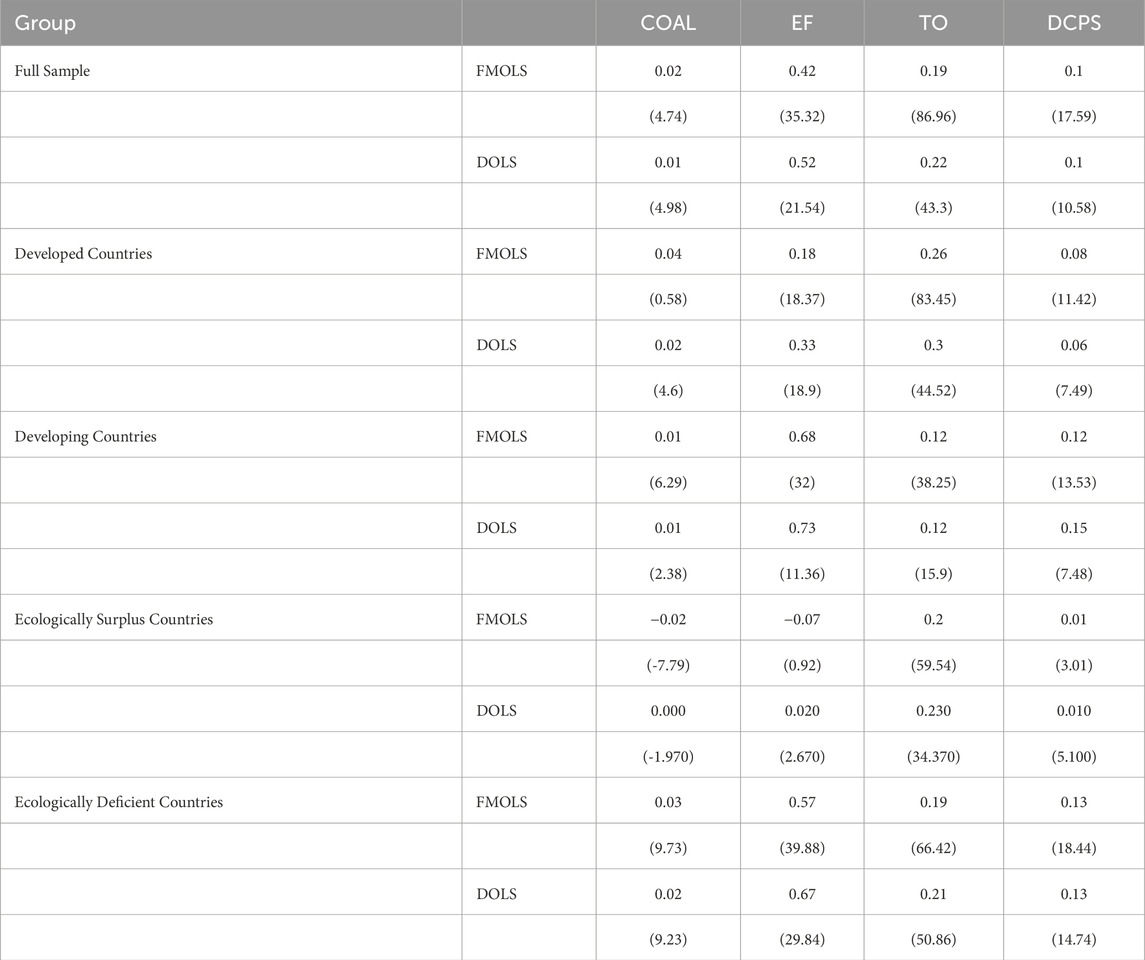
Table 8. FMOLS and DOLS estimation results. The results reveal that coal consumption significantly boosts economic growth in the short term, but contributes to long-term ecological degradation. Moreover, ecological footprint negatively correlates with growth in most countries, suggesting unsustainable resource use. These findings highlight the need for cleaner energy strategies in coal-dependent economies.
We divided the full sample into developed, developing, and ecological surplus/deficit countries. In developed countries, ecological footprint has a positive and significant effect on GDP (Beta =; p-value), but coal consumption is insignificant (Beta =; p-value), possibly due to an increase in the use of energy reduction strategies and the embracement of green energy systems. This suggests that developed countries promote economic activities at the expense of environmental sustainability. Also, the results for the developed countries indicated that trade openness (Beta =; p-value) has the largest effect, with DCPS promoting growth moderately. This result suggested that developed countries benefit from global trade integration.
In contrast to the results for the developed countries, developing countries benefit from increased coal consumption. Table 8 shows that a positive significant impact of coal consumption on GDP with both FMOLS (Beta =; p-value) and DOLS (Beta =; p-value) estimators. The results in Table 8 also shows that ecological footprint has a significant positive impact on GDP in developing countries (Beta =; p-value), suggesting higher economic growth in developing countries is associated with intense environmental degradation. Economic growth is reinforced by promoting trade openness and DCPS in developing countries. Results show that trade openness and DCPS have significant positive impacts on GDP. Thus, developing countries benefit from higher growth levels by being energy- and capital-intensive.
Furthermore, the results in Table 8 show that both coal consumption and ecological footprint have negative and significant effects on GDP. This suggests that the governments in ecologically surplus countries are sustainably managing coal use. In contrast, coal consumption and ecological footprint have positive and significant effects on GDP, indicating that ecologically deficit countries are growing at the cost of environmental degradation and stress. Similar to other groups, trade openness and DCPS maintain strong and positive impacts on economic growth.
3.6 Three stage least square results
3.6.1 Impact of coal consumption and ecological footprint on economic growth
For estimating the impact of coal consumption and ecological footprint on economic growth we employed the three-stage least square (3SLS). The 3sls model (1) of the full sample reported in Table 9 studies the impact of coal consumption and ecological footprint on economic growth. The results reveal that all variables are statistically significant at a 1% level. Coal consumption has a small but negative impact on economic growth, implying that a 1% increase in coal consumption will cause about a 0.07% decrease in GDP. However, the ecological footprint has a significant positive impact on economic growth implying that all things being equal, an 1% increase in coal consumption and ecological footprint will increase economic growth (real GDP) by 0.98%. Similarly, financial development has a positive influence on economic growth, indicating that a 1% increase in financial development will increase economic growth (real GDP) by 0.462%. However, the elasticities of the population are (−0.019) which indicates that a 1% increase in population will decrease the economic growth (real GDP) by 0.019% at a 1% significance level. Furthermore, trade openness has a positive but insignificant relationship with economic growth.

Table 9. The effect of coal consumption and ecological footprint on economic growth (3SLS estimation).
As far as developed and developing countries are concerned, the results of both developed and developing countries (as shown in model (1) of developed and developing countries reported in Table 9 exposes that ecological footprint has a significant positive impact on economic growth implying that all things being equal, an 1% increase in ecological footprint will increase economic growth (real GDP) by 0.982% and 0.953%. Though coal has a negative and significant impact on economic growth, i.e., a 1% increase in coal consumption will decrease the economic growth (real GDP) by 0.06% and 0.10% respectively. In addition, financial development has a positive and significant impact on economic growth in both developed and developing countries. Similarly, in developing countries, trade openness has a positive and significant impact on economic growth at 1% though positive but insignificant in developed countries. However, the population has a negative and significant impact on economic growth in developed countries at 1% but positive and insignificant in developing countries. Among all variables, both ecological footprint and financial development have high elasticities indicating that these two variables contribute most to economic growth.
The results of models (4 days) and (5e) disclose intriguing insights about the relationship between economic growth and various factors in ecological surplus and deficit nations. In the case of countries with an ecological surplus (model 4 days), the coefficients indicate that an increase in ecological footprint, financial development, and trade openness has significant and positive effects on economic growth. However, the coefficient for coal production is statistically insignificant, indicating that it has little effect on economic growth in these nations. Similarly, there is a small and statistically insignificant correlation between population and economic growth. In contrast to the results of ecological deficit countries presented in the model (5e), the coefficients for ecological footprint, financial development, and trade openness indicate significant and positive effects on economic growth. In addition, the coefficient for coal production is positive and significant, indicating that it contributes to economic growth in these nations. Additionally, there is a modest but statistically significant correlation between population and economic growth. These results indicate that factors such as ecological footprint, financial development, and trade openness drive economic growth in both ecologically surplus and deficit countries. However, the effects of coal consumption vary considerably between countries.
3.6.2 Impact of ecological footprint and economic growth on coal consumption
The results for the relationship of coal consumption with economic growth and ecological footprint are presented in Table 10. The results disclose that economic growth has a significantly negative impact on coal consumption in all three samples at 1%, implying that all other factors being constant, an 1% increase in economic growth will decrease coal consumption by 0.45% in the full sample, 1.59%. in developed countries and 1.38% in developing countries. These results are in line with Shahbaz et al. (2018) for top energy-consuming countries, Azam et al. (2015) concerning ASEAN countries and Bildirici and Bakirtas (2014) in BRICS economies. Similarly, the coefficients of ecological footprint show a significantly positive impact on coal consumption in all three samples, implying that a 1% increase in ecological footprint will increase coal consumption by 0.43% in the full sample, 1.22% in developed countries and 1.11% in developing countries. As far as other variables are concerned, population and FDI have a positive and significant impact on coal consumption in the full sample and developing countries. However, in developing countries, trade openness has a significant positive impact on economic growth but FDI has an insignificant impact.
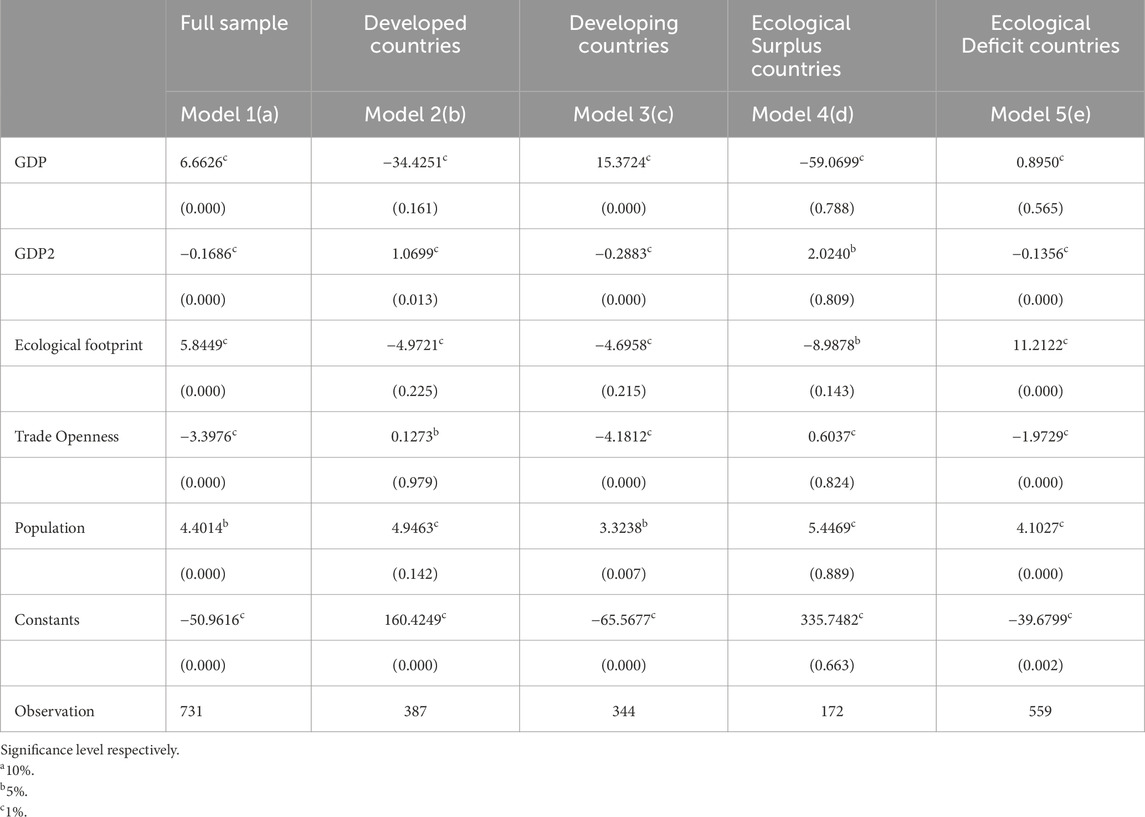
Table 10. The effect of ecological footprint and economic growth on coal consumption (3SLS estimation).
Moreover, models (4 days) and (5e) in Table 10 discloses the regression outcomes for ecological Surplus and ecological deficit countries. In the ecological surplus countries, the relationship between GDP and coal consumption is statistically significant and negative, indicating that a higher GDP is associated with lower coal consumption. There is a considerable positive correlation exists between ecological footprint and coal consumption, suggesting that countries with a larger ecological footprint tend to consume more coal. Additionally, population plays a significant impact, as a higher population correlates with increased coal consumption. Additionally, trade openness has a positive effect on the coal consumption of ecological surplus countries. In contrast, the ecological deficit model reveals a significant positive correlation between GDP and coal consumption, indicating that a higher GDP corresponds to higher coal consumption. Like the ecological surplus countries, the ecological footprint exhibits a positive correlation with coal consumption. Further, Population continues to exert a positive influence, whereas trade openness exerts a relatively lesser influence.
3.6.3 Impact of economic growth and coal consumption on ecological footprint
Table 11 exhibits the impact of economic growth and coal consumption on ecological footprint respectively for the full sample, developed countries and developing countries. The results disclose that except for developed countries, both economic growth and coal consumption have a significant positive impact on ecological footprint while for developed countries, GDP has a significant positive impact on ecological footprint but coal consumption has a significant negative impact on ecological footprint. These results are in line with past studies (e.g., Mensah et al. (2019)) that exhibit that consumption of fossil fuels leads to deterioration of environmental quality. Moreover, the coefficients of GDPsquare are positive and statistically significant for the full sample and developing countries which displays the non-existence of the EKC hypothesis, i.e (inverted U relationship). However, the coefficients of GDPsquare are negative and significant in developed countries which proved the existence of the EKC hypothesis. Besides, the coefficients of urbanisation indicate a significant positive impact on ecological footprint at 1%, while the coefficients of FDI are positive for the full sample at 10%. However, negative, and statistically insignificant for developed and developing countries.
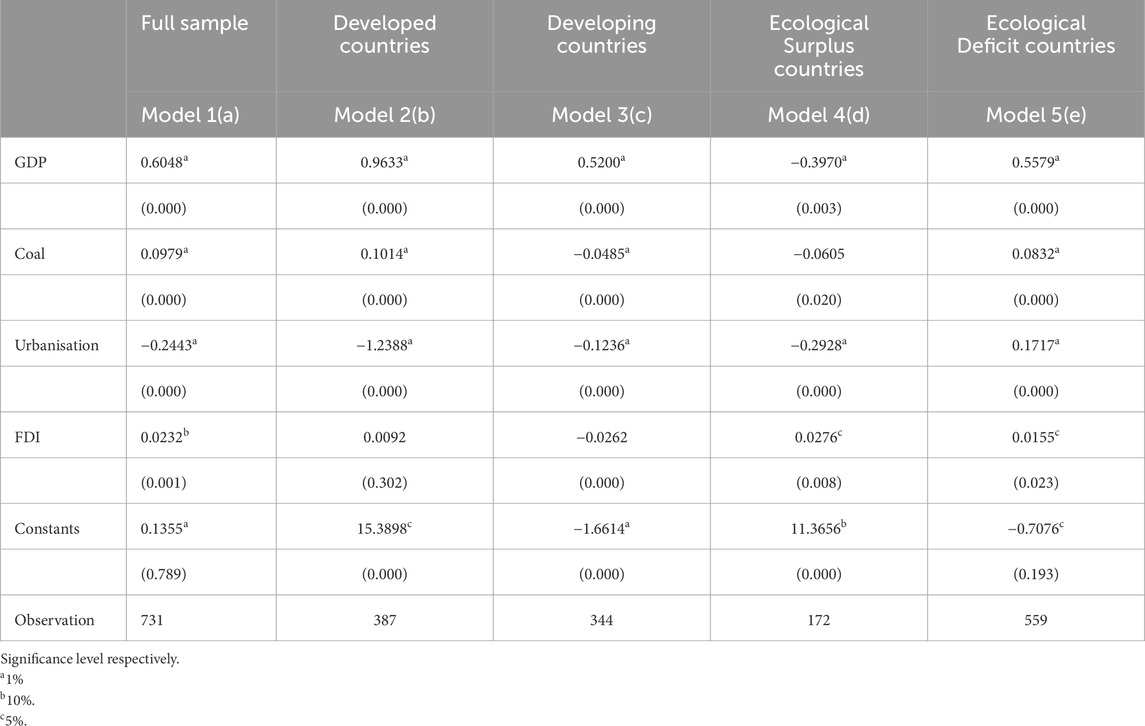
Table 11. The effect of coal consumption and economic growth on ecological footprint (3SLS estimation).
Further, examining Model (4 days), the GDP has a highly significant positive relationship with the ecological footprint. This finding suggests that nations with a higher GDP have a larger ecological footprint. In contrast, the coefficient for GDPsquare is not statistically significant, indicating that the data do not support the EKC hypothesis. Similarly, the coal variable lacks statistical significance, indicating that there is no significant relationship between coal consumption and ecological footprint. Moreover, urbanisation emerges as a robust and significant predictor of ecological footprint in both model (4 days) and model (5e). This indicates that greater urbanisation correlates with a larger ecological footprint. In addition, both models (4 days) and (5e) demonstrate a statistically significant negative correlation between FDI and ecological imprint. This suggests that countries that receive a greater amount of foreign direct investment have a reduced ecological footprint.
4 Discussion
This study investigated the relationship between economic growth (real GDP), coal consumption, and ecological footprint for 17 coal-based countries between 1980 and 2022. The findings of this study are summarized as follows: First, by looking at the results of unit root tests of Phillips-Perron test and ADF-Fisher, variables are stationary both at their level and first differences. Furthermore, the results of Hardi Z-stat represent that the null hypothesis of non-stationarity for whole panel variables can be rejected at levels I (0) and for some variables at first difference I (1), whereas Breitung t-stat shows the analysed variables are stationary at first differences. Second, the results for the Kao (1999), Pedroni (1999) and Westerlund (2007) panel cointegration test confirmed that the variables (economic growth, coal consumption, and ecological footprint) are cointegrated and hence possess a structural long-run relationship.
Third, results from FMOLS and DOLS estimators reveal significant positive relationships between coal consumption, ecological footprint and economic growth in developing and ecologically deficient countries. The results align with the findings of (Adebayo et al., 2023; Ding et al., 2023; Jin and Kim’s 2018; Kanat et al., 2022; Alper et al., 2022; Arshad et al., 2022; Benjamin and Olusegun, 2020; Hassan et al., 2019), emphasizing that developing countries prioritize industrialization and economic growth, often relying on coal due to its affordability and accessibility. This fossil fuel reliance results in significant environmental costs, which outweigh the economic benefits due to excessive or inefficient coal consumption, highlighting the environmental cost of energy-driven growth. In addition, economic growth drives higher consumption of energy and natural resources, leading to environmental degradation. Further, the usage of outdated technologies exacerbates this by increasing energy intensity and environmental harm (Wang et al., 2019).
Thirdly, the results of three-stage least square (3SLS) showed that coal consumption have a significant negative impact on the economic growth for all samples (Full, developed and developing) but positive for both ecological surplus and deficit countries. Similarly, for all samples (full, developed, developing ecological surplus and deficit countries), the ecological footprint has also a significant positive impact on economic growth, highlighting the extreme natural resources consumption, industrialisation, and infrastructure for rapid economic development, as such continued efforts and checks and balances must be in place to ensure institutionalized environmental quality policies and initiatives in coal-based countries. Further, for (Full, developed, developing and ecological surplus countries, the results of the influence of economic growth and ecological footprint on coal consumption revealed that economic growth has a significant negative influence on coal consumption but a positive impact on coal consumption for ecological deficit countries. This is accredited due to the reason that countries may have reached the stage where rates of savings are higher as compared to the rate of consumption. These accumulated funds have been used for energy-efficient technologies and to develop high technological industries. Also, learning from past experiences, these countries may have shifted from fossil fuel to renewable energy consumption or have implemented energy-efficient technologies to curb environmental damage. The results are consistent with Acheampong (2018) in the case of 116 countries, and Khan et al. (2019) in the case of 193 countries. However, ecological footprint coefficients are positive and significant, i.e., has a positive impact on coal consumption. This is attributed due to the reason that environmental deterioration through emission, ecological footprint, etc., are direct penalties for inefficient fossil fuel energy. These results are confirmed by Dong et al. (2019) for 128 countries across the globe.
In addition, the impact of economic growth and coal consumption on ecological footprints discloses that both economic growth and coal consumption have a significant positive impact on ecological footprint, implying that these countries are fossil-dependent countries. These results are justified by the reason that current renewable energy demands are still lower than required for these countries. Therefore, the rest of the energy demand is met by fossil energy resources for economic development. Further, these countries may lack the technologies that assist in the transition to renewable energy. The results are in line with Shahzad et al. (2021) in the case of the United States, Chen et al. (2019) in 16 CEE countries and Awosusi et al. (2023) in case of Japan., Adebayo et al. (2021a) in South Africa. However, the results are in contrast with Somoye and Ayobamiji (2024), who found that energy consumption and economic growrh are crucial driver of environmental sustainability. Furthermore, except for developed countries, it rejects the EKC hypothesis, i.e., an increase in economic growth increases ecological footprint up to a certain time, then finally declines. This is due to the reason that developing countries are still at the stage of development, there is a lack of energy-efficient technologies and proper environmental laws and regulations, these can protect the environment degradation. However, developed countries have strong environmental regulations, technological innovation and research which assist them to restrict the ecological footprint. The results are in line with Altıntaş and Kassouri (2020) in the case of ten European economies, Ren et al. (2021) with and Khan et al. (2019) in 193 countries.
5 Conclusion
This study provides an in-depth analysis of the nexus between energy-led growth and environment-led growth in top coal consuming countries. The results demonstrate that both coal consumption and ecological footprint are crucial drivers of economic growth in top coal-consuming countries. Hence, to accelerate economic growth, continued reliance on fossil fuels like coal, exacerbates environmental degradation in these countries. The study suggests that to align with the objectives of COP-28, focussed in transition away from fossil fuels and ensuring to maintain the global temperature within the 1.50 threshold, policymakers should focus on a gradual yet decisive transition from coal to renewable energy to address the environmental impacts of fossil fuel dependency, efforts must be intensified to boost the proportion of renewable energy in the overall energy mix. The concerned government should offer incentives for renewable energy infrastructure, green and renewable energy initiatives, investing in research and sustainable development, and removing regulatory hindrances. Additionally, policies that promote energy efficiency should integrate advanced energy-saving technologies, conducting public awareness campaigns, and enforcing stringent energy efficiency standards, enabling the continued use of conventional energy sources, including coal, in a more sustainable manner. Also, stakeholders must prioritize funding and intensify research and development efforts in cleaner coal technologies and carbon capture and storage (CCS) to shift towards more sustainable energy sources. Furthermore, stricter environmental regulations should be enforced to limit the adverse impacts of fossil fuel consumption. To ensure environmental quality, the respective governments should enforce penalties for non-compliance, emissions reduction targets, monitor pollution levels, promoting energy efficiency in industrial processes.
This study faces data availability limitation across the top seventeen coal-consuming countries. Additionally, geographical, and cultural differences among the countries may limit the generalizability of the results. Future research should incorporate additional variables such as technological innovation, energy policy, and energy efficiency to reduce pollution further and enhance sustainable growth. Additionally, future studies should conduct cross-region comparisons based on low and high coal consumption or those transitioning to renewable energy, allowing for tailored policy interventions. The empirical findings highlight the necessity of adopting a comprehensive energy policy that balances economic growth with environmental sustainability. To achieve sustainable development, coal-consuming countries should focus on accelerating the transition to renewable energy, improving energy efficiency, and enforcing strong environmental regulations. These measures can lead to enhanced quality of life for citizens while supporting long-term economic stability. The insights from this research provide crucial guidance for policymakers and stakeholders dedicated to fostering a sustainable energy future in coal-dependent nations.
Data availability statement
The raw data supporting the conclusions of this article will be made available by the authors, without undue reservation.
Author contributions
YA: Conceptualization, Data curation, Formal Analysis, Investigation, Methodology, Software, Supervision, Writing – original draft, Writing – review and editing. SR: Conceptualization, Data curation, Formal Analysis, Investigation, Methodology, Software, Validation, Writing – original draft, Writing – review and editing.
Funding
The author(s) declare that no financial support was received for the research and/or publication of this article.
Acknowledgments
We acknowledge that the content of our manuscript have previously appeared online as a preprint in the Research Square repository. The link is avaiable at: https://www.researchsquare.com/article/rs-3216141/v1.
Conflict of interest
The authors declare that the research was conducted in the absence of any commercial or financial relationships that could be construed as a potential conflict of interest.
Publisher’s note
All claims expressed in this article are solely those of the authors and do not necessarily represent those of their affiliated organizations, or those of the publisher, the editors and the reviewers. Any product that may be evaluated in this article, or claim that may be made by its manufacturer, is not guaranteed or endorsed by the publisher.
Abbreviations
COAL, Coal consumption; GDP, Economic growth; GDPsquare, Square of economic growth; EF, Ecological footprint; POP, Population; TRADEOPEN, Trade openness; FDI, Foreign Direct Investment; 3SLS, Three-stage least squares; ARDL, Autoregressive distributed lag; DOLS, Dynamic OLS; FMOLS, Fully Modified OLS; ADF, Augmented Dickey-Fuller.
References
Acheampong, A. O. (2018). Economic growth, CO2 emissions and energy consumption: what causes what and where? Energy Econ. 74, 677–692. doi:10.1016/j.eneco.2018.07.022
Adebayo, T. S., Akadiri, S. S., Altuntaş, M., and Awosusi, A. A. (2023). Environmental effects of structural change, hydro and coal energy consumption on ecological footprint in India: insights from the novel dynamic ARDL simulation. Environ. Dev. Sustain. 25 (12), 14309–14332. doi:10.1007/s10668-022-02665-0
Adebayo, T. S., Awosusi, A. A., Bekun, F. V., and Altuntaş, M. (2021a). Coal energy consumption beat renewable energy consumption in South Africa: developing policy framework for sustainable development. Renew. Energy 175, 1012–1024. doi:10.1016/j.renene.2021.05.032
Adebayo, T. S., Awosusi, A. A., Oladipupo, S. D., Agyekum, E. B., Jayakumar, A., and Kumar, N. M. (2021b). Dominance of fossil fuels in Japan’s national energy mix and implications for environmental sustainability. Int. J. Environ. Res. Public Health 18 (14), 7347. doi:10.3390/ijerph18147347
Ahmed, Z., Wang, Z., Mahmood, F., Hafeez, M., and Ali, N. (2019). Does globalization increase the ecological footprint? Empirical evidence from Malaysia. Environ. Sci. Pollut. Res. 26 (18), 18565–18582. doi:10.1007/s11356-019-05224-9
Ahmed, Z., Zafar, M. W., and Mansoor, S. (2020). Analyzing the linkage between military spending, economic growth, and ecological footprint in Pakistan: evidence from cointegration and bootstrap causality. Environ. Sci. Pollut. Res. 27, 41551–41567. doi:10.1007/s11356-020-10076-9
Al-mulali, U., and Che Sab, C. N. B. (2018). The impact of coal consumption and CO2 emission on economic growth. Energy Sources, Part B Econ. Plan. Policy 13 (4), 218–223. doi:10.1080/15567249.2012.661027
Al-mulali, U., Weng-wai, C., Sheau-ting, L., and Hakim, A. (2015). Investigating the environmental Kuznets curve (EKC) hypothesis by utilizing the ecological footprint as an indicator of environmental degradation. Ecol. Indic. 48, 315–323. doi:10.1016/j.ecolind.2014.08.029
Alper, A. E., Alper, F. O., Ozayturk, G., and Mike, F. (2022). Testing the long-run impact of economic growth, energy consumption, and globalization on ecological footprint: new evidence from Fourier bootstrap ARDL and Fourier bootstrap Toda–Yamamoto test results. Environ. Sci. Pollut. Res. 30, 42873–42888. doi:10.1007/s11356-022-18610-7
Altıntaş, H., and Kassouri, Y. (2020). Is the environmental Kuznets Curve in Europe related to the per-capita ecological footprint or CO2 emissions? Ecol. Indic. 113, 106187. doi:10.1016/j.ecolind.2020.106187
Anoruo, E. (2017). Coal consumption and economic growth nexus: evidence from bootstrap panel Granger causality test. Panoeconomicus 64 (3), 255–271. doi:10.2298/PAN140718019A
Apergis, N., and Payne, J. E. (2010). The emissions, energy consumption, and growth nexus: evidence from the commonwealth of independent states. Energy policy 38 (1), 650–655.
Arshad, M., Muhammed, A., Villanthenkodath, A., and Akram, V. (2022). The nexus between ecological footprint, economic growth, and energy poverty in sub - saharan Africa: a technological threshold approach. Environ. Dev. Sustain., 0123456789. doi:10.1007/s10668-022-02377-5
Ashir, G., Salahuddin, M., Alam, K., and Gow, J. (2017). Ecological footprint and real income: panel data evidence from the 27 highest emitting countries. Ecol. Indic. 77, 166–175. doi:10.1016/j.ecolind.2017.01.003
Awosusi, A. A., Adebayo, T. S., Kirikkaleli, D., Rjoub, H., and Altuntaş, M. (2023). Evaluating the determinants of load capacity factor in Japan: the impact of economic complexity and trade globalization. Nat. Resour. forum 48 (3), 743–762. doi:10.1111/1477-8947.12334
Awosusi, A. A., Ozdeser, H., Seraj, M., and Adegboye, O. R. (2024). Achieving carbon neutrality in energy transition economies: exploring the environmental efficiency of natural gas efficiency, coal efficiency, and resources efficiency. Clean Technol. Environ. Policy 27, 2103–2118. doi:10.1007/s10098-024-02932-w
Aye, G. C., and Edoja, P. E. (2017). Effect of economic growth on CO2 emission in developing countries: evidence from a dynamic panel threshold model. Cogent Econ. Finance 5 (1), 1379239–22. doi:10.1080/23322039.2017.1379239
Azam, M., Qayyum, A., Bakhtyar, B., and Emirullah, C. (2015). The causal relationship between energy consumption and economic growth in the ASEAN-5 countries. Renew. Sustain. Energy Rev. 47, 732–745. doi:10.1016/j.rser.2015.03.023
Bakhsh, K., Rose, S., Faisal, M., Ahmad, N., and Shahbaz, M. (2017). Economic growth, CO2 emissions, renewable waste and FDI relation in Pakistan: new evidences from 3SLS. J. Environ. Manag. 196, 627–632. doi:10.1016/j.jenvman.2017.03.029
Benjamin, O., and Olusegun, A. (2020). The role of non-renewable energy consumption in economic growth and carbon emission: evidence from oil-producing economies in Africa. Energy Strategy Rev. 27, 100434. doi:10.1016/j.esr.2019.100434
Bildirici, M. E., and Bakirtas, T. (2014). The relationship among oil, natural gas and coal consumption and economic growth in BRICTS (Brazil, Russian, India, China, Turkey and South Africa) countries. Energy 65, 134–144. doi:10.1016/j.energy.2013.12.006
Chang, T., Deale, D., Gupta, R., Hefer, R., Inglesi-, R., and Simo-kengne, B. (2017). The causal relationship between coal consumption and economic growth in the BRICS countries: evidence from panel-Granger causality tests. Energy Sources, Part B Econ. Plan. Policy 12 (2), 138–146. doi:10.1080/15567249.2014.912696
Charfeddine, L., and Mrabet, Z. (2017). The impact of economic development and social-political factors on ecological footprint: a panel data analysis for 15 MENA countries. Renew. Sustain. Energy Rev. 76 (March), 138–154. doi:10.1016/j.rser.2017.03.031
Chaudhry, I. S., Yusop, Z., and Habibullah, M. S. (2022). Financial inclusion-environmental degradation nexus in OIC countries: new evidence from environmental Kuznets curve using DCCE approach. Environ. Sci. Pollut. Res. 29 (4), 5360–5377. doi:10.1007/s11356-021-15941-9
Chen, S., Saud, S., Saleem, N., and Bari, M. W. (2019). Nexus between financial development, energy consumption, income level, and ecological footprint in CEE countries: do human capital and biocapacity matter? Environ. Sci. Pollut. Res. 26, 31856–31872. doi:10.1007/s11356-019-06343-z
Danish, , Zhang, B., Wang, Z., and Wang, B. (2018). Energy production, economic growth and CO2 emission: evidence from Pakistan. Nat. Hazards 90 (1), 27–50. doi:10.1007/s11069-017-3031-z
Destek, M. A. (2016). Renewable energy consumption and economic growth in newly industrialized countries: evidence from asymmetric causality test. Renew. Energy 95, 478–484. doi:10.1016/j.renene.2016.04.049
Destek, M. A., and Aslan, A. (2017). Renewable and non-renewable energy consumption and economic growth in emerging economies: evidence from bootstrap panel causality. Renew. Energy 111, 757–763. doi:10.1016/j.renene.2017.05.008
Ding, C., Awosusi, A. A., Abbas, S., and Ojekemi, O. R. (2023). Formulating ecological sustainability policies for India within the coal energy, biomass energy, and economic globalization framework. Environ. Sci. Pollut. Res. 30 (52), 112758–112772. doi:10.1007/s11356-023-30243-y
Dogan, E., and Inglesi-Lotz, R. (2020). The impact of economic structure to the environmental Kuznets curve (EKC) hypothesis: evidence from European countries. Environ. Sci. Pollut. Res. 27, 12717–12724. doi:10.1007/s11356-020-07878-2
Dogan, E., Ulucak, R., Kocak, E., and Isik, C. (2020). The use of ecological footprint in estimating the Environmental Kuznets Curve hypothesis for BRICST by considering cross-section dependence and heterogeneity. Sci. Total Environ. 723, 138063. doi:10.1016/j.scitotenv.2020.138063
Dong, K., Dong, X., Dong, C., and Dong, K. (2019). Determinants of the global and regional CO2 emissions: what causes what and where ? Determinants of the global and regional CO2 emissions: what causes what and. Appl. Econ. 51 (46), 5031–5044. doi:10.1080/00036846.2019.1606410
Fatima, N., Xuhua, H., Alnafisah, H., and Akhtar, M. R. (2024). Synergy for climate actions in G7 countries: Unraveling the role of environmental policy stringency between technological innovation and CO2 emission interplay with DOLS, FMOLS and MMQR approaches. Energy Rep. 12, 1344–1359.
Grossman, G. M., Krueger, A. B., Brown, D., Evans, G., and Schoepfle, G. (1991). Environmental impacts of a north American free trade agreement. NBER Work. doi:10.3386/w3914
Hardi, I., Idroes, G. M., Zulham, T., Suriani, S., and Saputra, J. (2023). Economic growth, agriculture, capital formation and greenhouse gas emissions in Indonesia: FMOLS, DOLS and CCR applications. Ekonomikalia Journal of Economics 1 (2), 82–91.
Hassan, S. T., Xia, E., Khan, N. H., and Shah, S. M. A. (2019). Economic growth, natural resources, and ecological footprints: evidence from Pakistan. Environ. Sci. Pollut. Res. 26, 2929–2938. doi:10.1007/s11356-018-3803-3
Ibrahim, R. L., Huang, Y., Mohammed, A., and Adebayo, T. S. (2023). Natural resources-sustainable environment conflicts amidst COP26 resolutions: investigating the role of renewable energy, technology innovations, green finance, and structural change. Int. J. Sustain. Dev. World Ecol. 30 (4), 445–457.
IEA (2021). Coal information: overview. Paris: IEA. Available online at: https://www.iea.org/reports/coal-information-overview.
IEA (2024). World Energy Outlook 2024. Paris: IEA. Available online at: https://www.iea.org/reports/world-energy-outlook-2024., Licence: CC BY 4.0 (report); CC BY NC SA 4.0 (Annex A)
International Energy Associatoion (2022). Coal (online). Available online at: https://www.iea.org/energy-system/fossil-fuels/coal (Accessed June 20, 2023).
Jia, Z., Wen, S., and Sun, Z. (2022). Current relationship between coal consumption and the economic development and China's future carbon mitigation policies. Energy Policy 162, 112812. doi:10.1016/j.enpol.2022.112812
Jie, H., Khan, I., Alharthi, M., Zafar, M. W., and Saeed, A. (2023). Sustainable energy policy, socio-economic development, and ecological footprint: The economic significance of natural resources, population growth, and industrial development. Util. Policy 81, 101490.
Jin, T., and Kim, J. (2018). Coal consumption and economic growth: panel cointegration and causality evidence from OECD and non-OECD countries. Sustainability 10 (3), 660. doi:10.3390/su10030660
Kanat, O., Yan, Z., Asghar, M. M., Ahmed, Z., Mahmood, H., Kirikkaleli, D., et al. (2022). Do natural gas, oil, and coal consumption ameliorate environmental quality? Empirical evidence from Russia. Environ. Sci. Pollut. Res. 29 (3), 4540–4556. doi:10.1007/s11356-021-15989-7
Kao, C. (1999). Spurious regression and residual-based tests for cointegration in panel data. J. Econom. 90 (1), 1–44.
Khan, S., Peng, Z., and Li, Y. (2019). Energy consumption, environmental degradation, economic growth and financial development in globe: dynamic simultaneous equations panel analysis. Energy Rep. 5, 1089–1102. doi:10.1016/j.egyr.2019.08.004
Kihombo, S., Vaseer, A. I., Ahmed, Z., Chen, S., Kirikkaleli, D., and Adebayo, T. S. (2022). Is there a tradeoff between financial globalization, economic growth, and environmental sustainability? An advanced panel analysis. Environ. Sci. Pollut. Res. 29 (3), 3983–3993. doi:10.1007/s11356-021-15878-z
Kim, H. M., and Yoo, S. H. (2016). Coal consumption and economic growth in Indonesia. Energy Sources, Part B Econ. Plan. Policy 11 (6), 547–552. doi:10.1080/15567249.2012.690503
Kongkuah, M., Yao, H., and Yilanci, V. (2021). The relationship between energy consumption, economic growth, and - CO2 emissions in China: the role of urbanisation and international trade. Environ. Dev. Sustain. 24, 4684–4708. doi:10.1007/s10668-021-01628-1
Li, H. (2023a). Advancing “carbon peak” and “carbon neutrality” in China: a comprehensive review of current global research on carbon capture, utilization, and storage technology and its implications. ACS omega 8 (45), 42086–42101. doi:10.1021/acsomega.3c06422
Li, H. (2023b). Coordinated development of shale gas benefit exploitation and ecological environmental conservation in China: a mini review. Front. Ecol. Evol. 11, 1232395. doi:10.3389/fevo.2023.1232395
Li, J., and Li, Z. (2011). A causality analysis of coal consumption and economic growth for China and India. Nat. Resour. 2 (1), 54–60. doi:10.4236/nr.2011.21007
Li, W., Yu, X., Hu, N., Huang, F., Wang, J., and Peng, Q. (2022). Study on the relationship between fossil energy consumption and carbon emission in Sichuan Province. Energy Rep. 8, 53–62. doi:10.1016/j.egyr.2022.01.112
Lin, D., Hanscom, L., Murthy, A., Galli, A., Evans, M., Neill, E., et al. (2018). Ecological footprint accounting for countries: updates and results of the National Footprint Accounts, 2012–2018. Resources 7 (3), 58.
Majeed, M. T., Tauqir, A., Mazhar, M., and Samreen, I. (2021). Asymmetric effects of energy consumption and economic growth on ecological footprint: new evidence from Pakistan. Environ. Sci. Pollut. Res. 28, 32945–32961. doi:10.1007/s11356-021-13130-2
Malik, M. A. (2021). Economic growth, energy consumption, and environmental quality nexus in Turkey: evidence from simultaneous equation models. Environ. Sci. Pollut. Res. 28 (31), 41988–41999. doi:10.1007/s11356-021-13468-7
Mensah, I. A., Sun, M., Gao, C., Omari-Sasu, A. Y., Zhu, D., Ampimah, B. C., et al. (2019). Analysis on the nexus of economic growth, fossil fuel energy consumption, CO2 emissions and oil price in Africa based on a PMG panel ARDL approach. J. Clean. Prod. 228, 161–174. doi:10.1016/j.jclepro.2019.04.281
Nasiru, I. (2012). Coal consumption and economic growth in Nigeria: a two-step residual-based test approach to cointegration. Eur. Sci. J. 8 (9), 140–155. doi:10.19044/esj.2012.v8n9p%25p
Nathaniel, S. P., and Nathaniel, S. P. (2020). The nexus between economic growth, energy use, international trade and ecological footprints: the role of environmental regulations in N11 countries. Energy, Ecol. Environ. doi:10.1007/s40974-020-00205-y
Panayotou, T. (1993). Empirical tests and policy analysis of environmental degradation at different stages of economic development. Geneva: International Labour Organization.
Pata, U. K. (2018). The influence of coal and noncarbohydrate energy consumption on CO2 emissions: revisiting the environmental Kuznets curve hypothesis for Turkey. Energy 160, 1115–1123. doi:10.1016/j.energy.2018.07.095
Pedroni, P. (1999). Critical values for cointegration tests in heterogeneous panels with multiple regressors. Oxf. Bull. Econ. Statistics 61 (S1), 653–670. doi:10.1111/1468-0084.0610s1653
Phillips, P. C., and Hansen, B. E. (1990). Statistical inference in instrumental variables regression with I (1) processes. The review of economic studies 57 (1), 99–125.
Rahman, M., and Velayutham, E. (2020). Renewable and non-renewable energy consumption-economic growth nexus: new evidence from South Asia. Renew. Energy 147 (2020), 399–408. doi:10.1016/j.renene.2019.09.007
Rahman, Z. U., and Ahmad, M. (2019). Modeling the relationship between gross capital formation and CO2 (a) symmetrically in the case of Pakistan: an empirical analysis through NARDL approach. Environ. Sci. Pollut. Res. 26, 8111–8124. doi:10.1007/s11356-019-04254-7
Rees, W. E. (2000). Eco-footprint analysis: merits and brickbats. Ecol. Econ. 32 (3), 371–374. doi:10.1016/S0921-8009(99)00157-3
Ren, Y. S., Apergis, N., Ma, C., Baltas, K., Jiang, Y., and Liu, J. L. (2021). FDI, economic growth, and carbon emissions of the Chinese steel industry: new evidence from a 3SLS model. Environ. Sci. Pollut. Res. 28 (37), 52547–52564. doi:10.1007/s11356-021-14445-w
Salahuddin, M., Alam, K., Ozturk, I., and Sohag, K. (2018). The effects of electricity consumption, economic growth, financial development and foreign direct investment on CO2 emissions in Kuwait. Renew. Sustain. Energy Rev. 81 (March 2016), 2002–2010. doi:10.1016/j.rser.2017.06.009
Shahbaz, M., Balsalobre, D., and Shahzad, S. J. H. (2019). The influencing factors of CO2 emissions and the role of biomass energy consumption: statistical experience from G-7 countries. Environ. Model. Assess. 24 (2), 143–161. doi:10.1007/s10666-018-9620-8
Shahbaz, M., Zakaria, M., Shahzad, S. J. H., and Mahalik, M. K. (2018). The energy consumption and economic growth nexus in top ten energy-consuming countries: fresh evidence from using the quantile-on-quantile approach. Energy Econ. 71, 282–301. doi:10.1016/j.eneco.2018.02.023
Shahzad, U., Fareed, Z., Shahzad, F., and Shahzad, K. (2021). Investigating the nexus between economic complexity, energy consumption and ecological footprint for the United States: new insights from quantile methods. J. Clean. Prod. 279, 123806. doi:10.1016/j.jclepro.2020.123806
Somoye, O. A., and Ayobamiji, A. A. (2024). “Can energy intensity, clean energy utilization, economic expansion, and financial development contribute to ecological progress in Iceland? A quantile-on-quantile KRLS analysis,” in Natural resources forum (Oxford, UK: Blackwell Publishing Ltd).
Stock, J. H., and Watson, M. W. (1993). A simple estimator of cointegrating vectors in higher order integrated systems. Econometrica: journal of the Econometric Society, 783–820.
Tauseef, S., Awais, M., Mahmood, N., and Zhang, J. (2019). Linking economic growth and ecological footprint through human capital and biocapacity. Sustain. Cities Soc. 47 (January), 101516. doi:10.1016/j.scs.2019.101516
Ulucak, R., and Bilgili, F. (2018). A reinvestigation of EKC model by ecological footprint measurement for high, middle and low income countries. J. Clean. Prod. 188, 144–157. doi:10.1016/j.jclepro.2018.03.191
Wackernagel, M., and Rees, W. (1998). Our ecological footprint: reducing human impact on the earth, 9. Gabriola Island, B.C. Canada: New Society Publishers.
Wang, X., Zhang, T., Nathwani, J., Yang, F., and Shao, Q. (2022). Environmental regulation, technology innovation, and low carbon development: revisiting the EKC Hypothesis, Porter Hypothesis, and Jevons’ Paradox in China's iron and steel industry. Technol. Forecast. Soc. Change 176, 121471. doi:10.1016/j.techfore.2022.121471
Wang, Z., Rasool, Y., Asghar, M. M., and Wang, B. (2019). Dynamic linkages among CO 2 emissions, human development, financial development, and globalization: empirical evidence based on PMG long-run panel estimation. Environ. Sci. Pollut. Res. 26, 36248–36263. doi:10.1007/s11356-019-06556-2
Westerlund, J. (2007). Testing for error correction in panel data. Oxf. Bull. Econ. Statistics 69 (6), 709–748. doi:10.1111/j.1468-0084.2007.00477.x
Westerlund, J., and Edgerton, D. L. (2007). A panel bootstrap cointegration test. Econ. lett. 97 (3), 185–190.
Keywords: ecological footprint, coal consumption, economic growth, coal countries, ecological surplus countries, ecological deficit countries
Citation: Adeneye YB and Rasheed S (2025) Impact of coal consumption, ecological footprint on economic growth: new evidence from top seventeen coal countries. Front. Energy Res. 13:1490841. doi: 10.3389/fenrg.2025.1490841
Received: 03 September 2024; Accepted: 07 July 2025;
Published: 31 July 2025.
Edited by:
Lin Ma, The University of Manchester, United KingdomReviewed by:
Hu Li, Sichuan University of Science and Engineering, ChinaAbraham Awosusi, Near East University, Cyprus
Copyright © 2025 Adeneye and Rasheed. This is an open-access article distributed under the terms of the Creative Commons Attribution License (CC BY). The use, distribution or reproduction in other forums is permitted, provided the original author(s) and the copyright owner(s) are credited and that the original publication in this journal is cited, in accordance with accepted academic practice. No use, distribution or reproduction is permitted which does not comply with these terms.
*Correspondence: Shahida Rasheed, c2hhaGlkYS5zY2hvbGFyQGthc2htaXJ1bml2ZXJzaXR5Lm5ldA==
 Yusuf Babatunde Adeneye
Yusuf Babatunde Adeneye Shahida Rasheed
Shahida Rasheed